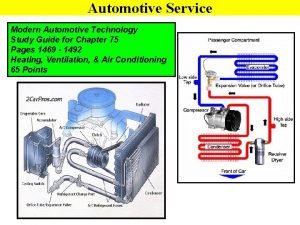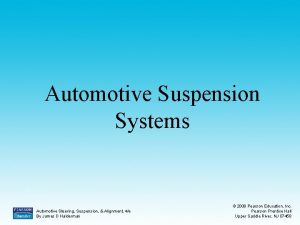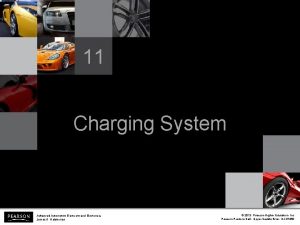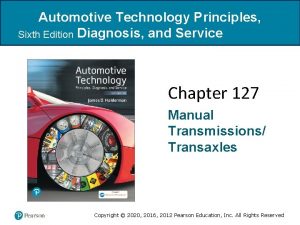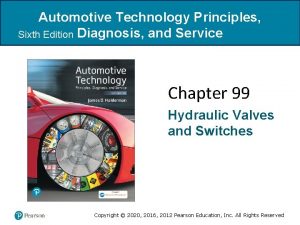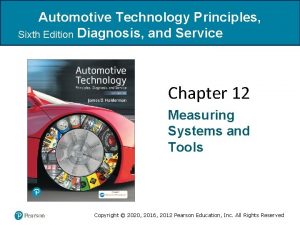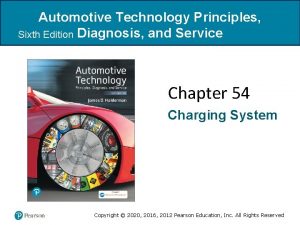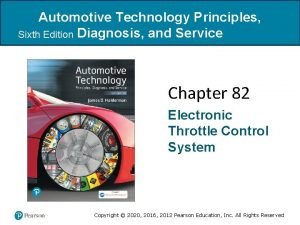Automotive Technology Principles Sixth Edition Diagnosis and Service























































- Slides: 55

Automotive Technology Principles, Sixth Edition Diagnosis, and Service Chapter 51 Battery Testing and Service Copyright © 2018, 2015, 2011 Pearson Education, Inc. All Rights Reserved Copyright © 2020, 2016, 2012 Pearson Education, Inc. All Rights Reserved

LEARNING OBJECTIVES (1 of 2) 51. 1 List the precautions for working with batteries. 51. 2 List the symptoms of a weak or defective battery. 51. 3 Describe how to inspect and clean terminals and hold-downs. 51. 4 Discuss how to test batteries for open circuit voltage and specific gravity. 51. 5 Describe how to perform a battery load test and a conductance test. Copyright © 2020, 2016, 2012 Pearson Education, Inc. All Rights Reserved

LEARNING OBJECTIVES (2 of 2) 51. 6 Explain how to safely charge or jump start a battery. 51. 7 Discuss how to perform a battery drain test. 51. 8 Describe how to prevent loss of memory functions and reinitialize memory functions. 51. 9 This chapter will help you prepare for the ASE Electrical/Electronic Systems (A 6) certification test content area “B” (Battery Diagnosis and Service). Copyright © 2020, 2016, 2012 Pearson Education, Inc. All Rights Reserved

BATTERY SERVICE SAFETY CONSIDERATIONS • Hazards – Batteries contain acid and release explosive gases (hydrogen and oxygen) during normal charging and discharging cycles. • Safety Procedures – Disconnect the negative battery cable from the battery. – Wear eye protection and protective clothing – Follow all safety precautions – Never jump-start a frozen battery Copyright © 2020, 2016, 2012 Pearson Education, Inc. All Rights Reserved

SYMPTOMS OF A WEAK OR DEFECTIVE BATTERY • The following warning signs indicate that a battery is near the end of its useful life. – Uses water in one or more cells. – Excessive corrosion on battery cables or connections. – Slower than normal engine cranking. Copyright © 2020, 2016, 2012 Pearson Education, Inc. All Rights Reserved

Figure 51. 1 A visual inspection on this battery shows the electrolyte level is below the plates in all cells. Not many batteries can be checked for the electrolyte level and, if low, the battery is likely at the end of its normal service life Copyright © 2020, 2016, 2012 Pearson Education, Inc. All Rights Reserved

Figure 51. 2 Corrosion on a battery cable could be an indication that the battery itself is either being overcharged or is sulfated, creating a lot of gassing of the electrolyte Copyright © 2020, 2016, 2012 Pearson Education, Inc. All Rights Reserved

BATTERY MAINTENANCE • Need for Maintenance – Most new-style batteries are of a maintenance-free design • Battery Terminal Cleaning – Use 1 tablespoon of baking soda in 1 quart (liter) of water to neutralize the acid. • Battery Hold-Down – The hold-down bracket should be snug enough to prevent battery movement. Copyright © 2020, 2016, 2012 Pearson Education, Inc. All Rights Reserved

Figure 51. 3 Using a baking soda and water paste to remove the corrosion on a battery terminal Copyright © 2020, 2016, 2012 Pearson Education, Inc. All Rights Reserved

BATTERY VOLTAGE TEST • State of Charge – Testing the battery voltage with a voltmeter. – Sometimes referred to as an open circuit battery voltage test. – Surface charge may need to be removed before testing. Copyright © 2020, 2016, 2012 Pearson Education, Inc. All Rights Reserved

Figure 51. 4 (a) A voltage reading of 12. 28 volts indicates that the battery is not fully charged and should be charged before testing Copyright © 2020, 2016, 2012 Pearson Education, Inc. All Rights Reserved

Figure 51. 4 (b) A battery that measures 12. 6 volts or higher after the surface charge has been removed is 100% charged Copyright © 2020, 2016, 2012 Pearson Education, Inc. All Rights Reserved

Chart 51 -1 Copyright © 2020, 2016, 2012 Pearson Education, Inc. All Rights Reserved

QUESTION 1: ? What is the battery state of charge test? Copyright © 2020, 2016, 2012 Pearson Education, Inc. All Rights Reserved

ANSWER 1: An open circuit test of the battery with a voltmeter after the surface charge has been removed. Copyright © 2020, 2016, 2012 Pearson Education, Inc. All Rights Reserved

HYDROMETER TESTING • If the battery has removable filler caps, the specific gravity of the electrolyte can also be checked. • A hydrometer is a tester that measures the specific gravity. Copyright © 2020, 2016, 2012 Pearson Education, Inc. All Rights Reserved

Figure 51. 5 When testing a battery using a hydrometer, the reading must be corrected if the temperature is above or below 80°F (27°C) Copyright © 2020, 2016, 2012 Pearson Education, Inc. All Rights Reserved

Chart 51 -2 Copyright © 2020, 2016, 2012 Pearson Education, Inc. All Rights Reserved

BATTERY LOAD TESTING • Terminology – A load test measures the number of amperes the battery can supply for 30 seconds at 0°F (-18°C). • Test Procedure – – Determine the CCA rating of the battery. Connect the load tester to the battery. Apply the load for a full 15 seconds. Repeat the test. Copyright © 2020, 2016, 2012 Pearson Education, Inc. All Rights Reserved

Figure 51. 6 This battery has a CCA rating of 600 amperes and a reserve capacity (RC) of 110 minutes Copyright © 2020, 2016, 2012 Pearson Education, Inc. All Rights Reserved

Figure 51. 7 A Snap-on battery tester that is capable of performing a battery load test, as well as starter and alternator amperage tests Copyright © 2020, 2016, 2012 Pearson Education, Inc. All Rights Reserved

QUESTION 2: ? What are the steps for performing a battery load test? Copyright © 2020, 2016, 2012 Pearson Education, Inc. All Rights Reserved

ANSWER 2: 1. 2. 3. 4. Determine the CCA rating of the battery. Connect the load tester to the battery. Apply the load for a full 15 seconds. Repeat the test. Copyright © 2020, 2016, 2012 Pearson Education, Inc. All Rights Reserved

FREQUENTLY ASKED QUESTION Copyright © 2020, 2016, 2012 Pearson Education, Inc. All Rights Reserved

Figure 51. 8 Most light-duty vehicles equipped with two batteries are connected in parallel as shown. Two 500 -amperes, 12 -volt batteries are capable of supplying 1, 000 amperes at 12 volts, which is needed to start many diesel engines Copyright © 2020, 2016, 2012 Pearson Education, Inc. All Rights Reserved

Figure 51. 9 Many heavy-duty trucks and buses use two 12 -volt batteries connected in series to provide 24 volts Copyright © 2020, 2016, 2012 Pearson Education, Inc. All Rights Reserved

ELECTRICAL CONDUCTANCE TESTING • Terminology – Conductance is a measure of how well a battery can create current. • Test Procedure – – Connect the unit to the battery. Enter the CCA rating of the battery. Begin the test. The tester will display the results. Copyright © 2020, 2016, 2012 Pearson Education, Inc. All Rights Reserved

Figure 51. 10 A conductance tester is very easy to use and has proved to accurately determine battery condition, if the connections are properly made. Follow the instructions on the display exactly for best results Copyright © 2020, 2016, 2012 Pearson Education, Inc. All Rights Reserved

Figure 51. 11 A Midtronics tester that can not only test the battery but can also detect faults with the starter and alternator Copyright © 2020, 2016, 2012 Pearson Education, Inc. All Rights Reserved

BATTERY CHARGING • Charging Procedure – – Determine charge rate Connect battery charger to battery Plug in charger to outlet Set the charging rate Copyright © 2020, 2016, 2012 Pearson Education, Inc. All Rights Reserved

Figure 51. 12 A typical industrial battery charger. Always follow the battery charger manufacturer’s instructions Copyright © 2020, 2016, 2012 Pearson Education, Inc. All Rights Reserved

Chart 51 -3 Battery charging guideline showing the charging times that vary according to state of charge, temperature, and charging rate. Copyright © 2020, 2016, 2012 Pearson Education, Inc. All Rights Reserved

TECH TIP Copyright © 2020, 2016, 2012 Pearson Education, Inc. All Rights Reserved

Figure 51. 13 Adapters should be used on side-terminal batteries whenever charging Copyright © 2020, 2016, 2012 Pearson Education, Inc. All Rights Reserved

BATTERY CHARGE TIME • Copyright © 2020, 2016, 2012 Pearson Education, Inc. All Rights Reserved

JUMP STARTING • When using jumper cables or a battery jump box, the last connection made should always be on the engine block or an engine bracket on the dead vehicle as far from the battery as possible. • Many newer vehicles have special ground and/or positive power connections built away from the battery just for the purpose of jump starting. Copyright © 2020, 2016, 2012 Pearson Education, Inc. All Rights Reserved

Figure 51. 14 A typical battery jump box used to jump start vehicles. These hand-portable units have almost made jumper cables obsolete Copyright © 2020, 2016, 2012 Pearson Education, Inc. All Rights Reserved

TECH TIP Copyright © 2020, 2016, 2012 Pearson Education, Inc. All Rights Reserved

Figure 51. 15 The sticker on this battery indicates that it was shipped from the factory January, 2015 Copyright © 2020, 2016, 2012 Pearson Education, Inc. All Rights Reserved

BATTERY ELECTRICAL DRAIN TESTING (1 OF 2) • The battery electrical drain test determines if any component or circuit in a vehicle is causing a drain on the battery when everything is off. • Using an Inductive DC ammeter – The fastest and easiest method to measure battery electrical drain – Clamp around either cable – Capable of measuring low current (10 milliamperes) Copyright © 2020, 2016, 2012 Pearson Education, Inc. All Rights Reserved

BATTERY ELECTRICAL DRAIN TESTING (2 OF 2) • Using a DMM set to read milliamperes – Make certain that all lights, accessories, and ignition are off. – Disconnect the negative (-) battery cable and install a parasitic load tool. – Start the engine and drive the vehicle about 10 minutes. – Connect an ammeter across the parasitic load tool switch and wait 20 minutes – Open the switch on the load tool and read the battery electrical drain on the meter display Copyright © 2020, 2016, 2012 Pearson Education, Inc. All Rights Reserved

Figure 51. 16 This mini clamp-on digital multimeter is being used to measure the amount of battery electrical drain that is present. In this case, a reading of 20 milliamperes (displayed on the meter as 00. 02 ampere) is within the normal range of 20 to 30 milliamperes. Copyright © 2020, 2016, 2012 Pearson Education, Inc. All Rights Reserved

Figure 51. 17 After connecting the shut-off tool, start and shut off the engine Connect the ammeter across the shut-off switch in parallel. Wait 20 minutes. Open the switch–all; current now flows through the ammeter. Record the results. Copyright © 2020, 2016, 2012 Pearson Education, Inc. All Rights Reserved

QUESTION 3: ? How is a battery drain test performed? Copyright © 2020, 2016, 2012 Pearson Education, Inc. All Rights Reserved

ANSWER 3: With an inductive DC ammeter or a DMM set to read milliamperes. . Copyright © 2020, 2016, 2012 Pearson Education, Inc. All Rights Reserved

MAINTAINING ELECTRONIC MEMORY FUNCTIONS • Disconnect Issues – Security system, PCM relearn, Windows/Sunroof • Maintaining Memory Methods – 9 or 12 volt supply at DLC or Power Plug (lighter) • Re-initialization – Power windows, Radio antitheft, intelligent battery systems Copyright © 2020, 2016, 2012 Pearson Education, Inc. All Rights Reserved

Figure 51. 18 The battery was replaced in this Ford Focus and the radio displayed “enter code” when the replacement battery was installed. A code is required to unlock the radio. Copyright © 2020, 2016, 2012 Pearson Education, Inc. All Rights Reserved

Figure 51. 19 A special tool that includes a lighter plug what can be plugged into a jump-start battery unit and the other end connected to the data link connector (DLC) of the vehicle to maintain the memory functions Copyright © 2020, 2016, 2012 Pearson Education, Inc. All Rights Reserved

Figure 51. 20 A memory saver tool that uses a 12 -volt battery to connect to the power (terminal 16) and ground (terminals 4 and 5) of the DLC Copyright © 2020, 2016, 2012 Pearson Education, Inc. All Rights Reserved

TECH TIP Copyright © 2020, 2016, 2012 Pearson Education, Inc. All Rights Reserved

Figure 51. 21 (a) Memory saver. The part numbers represent components from Radio. Shack Copyright © 2020, 2016, 2012 Pearson Education, Inc. All Rights Reserved

Figure 51. 21 (b) A schematic drawing of the same memory saver. Some experts recommend using a 12 -volt lantern battery, instead of a small 9 -volt battery, to help ensure there is enough voltage. Copyright © 2020, 2016, 2012 Pearson Education, Inc. All Rights Reserved

FREQUENTLY ASKED QUESTION Copyright © 2020, 2016, 2012 Pearson Education, Inc. All Rights Reserved

Figure 51. 22 Many newer vehicles have batteries that are sometimes difficult to find. Some are located under plastic panels under the hood, under the front fender, or even under the rear seat, as shown here Copyright © 2020, 2016, 2012 Pearson Education, Inc. All Rights Reserved

Copyright © 2020, 2016, 2012 Pearson Education, Inc. All Rights Reserved
 Automotive technology sixth edition
Automotive technology sixth edition Automotive technology sixth edition
Automotive technology sixth edition Principles of economics sixth edition
Principles of economics sixth edition Peter piper tongue twister
Peter piper tongue twister Rubber baby buggy bumpers tongue twister lyrics
Rubber baby buggy bumpers tongue twister lyrics Automotive heating and air conditioning 8th edition
Automotive heating and air conditioning 8th edition Biochemistry sixth edition 2007 w.h. freeman and company
Biochemistry sixth edition 2007 w.h. freeman and company Automotive engines 8th edition
Automotive engines 8th edition China automotive technology & research center
China automotive technology & research center Computer architecture a quantitative approach sixth edition
Computer architecture a quantitative approach sixth edition Citation sample pdf
Citation sample pdf Computer architecture a quantitative approach 6th
Computer architecture a quantitative approach 6th Precalculus sixth edition
Precalculus sixth edition Computer architecture a quantitative approach sixth edition
Computer architecture a quantitative approach sixth edition The nursing process
The nursing process Medical diagnosis and nursing diagnosis difference
Medical diagnosis and nursing diagnosis difference Second phase of nursing process
Second phase of nursing process Types of nursing diagnoses
Types of nursing diagnoses Modern automotive technology answer key
Modern automotive technology answer key Automotive technology chapter 51 answers
Automotive technology chapter 51 answers Mechanical technology automotive grade 11
Mechanical technology automotive grade 11 Autocaat
Autocaat Rivet split pin dublin
Rivet split pin dublin Sixth sense technology seminar report
Sixth sense technology seminar report Sixth sense technology seminar
Sixth sense technology seminar Sixth sense ted
Sixth sense ted Perbedaan diagnosis gizi dan diagnosis medis
Perbedaan diagnosis gizi dan diagnosis medis Chapter 81 brake system technology answers key
Chapter 81 brake system technology answers key Mis chapter 6
Mis chapter 6 Chapter 1
Chapter 1 Computer security principles and practice 4th edition
Computer security principles and practice 4th edition Computer security principles and practice 4th edition
Computer security principles and practice 4th edition Expert systems: principles and programming, fourth edition
Expert systems: principles and programming, fourth edition Kasavana and smith matrix
Kasavana and smith matrix Food and beverage service' 9 th edition
Food and beverage service' 9 th edition The four realms of experience
The four realms of experience Food and beverage management notes
Food and beverage management notes Food and beverage service standards manual
Food and beverage service standards manual Food and beverage service' 9 th edition
Food and beverage service' 9 th edition Information technology project management 9th edition
Information technology project management 9th edition Information technology project management 9th edition ppt
Information technology project management 9th edition ppt Ethics in information technology 6th edition answers
Ethics in information technology 6th edition answers Ethics in information technology fourth edition
Ethics in information technology fourth edition Information technology project management 8th edition
Information technology project management 8th edition Information technology project management 9th edition
Information technology project management 9th edition Basic environmental technology
Basic environmental technology Information technology project management 9th edition
Information technology project management 9th edition Automotive regulations and standards
Automotive regulations and standards Chapter 44 automotive wiring and wire repair
Chapter 44 automotive wiring and wire repair Automotive steering, suspension and alignment
Automotive steering, suspension and alignment Advanced automotive electricity and electronics
Advanced automotive electricity and electronics Chapter 2 automotive careers and ase certification
Chapter 2 automotive careers and ase certification Auto upkeep answer key
Auto upkeep answer key Fasteners gaskets seals and sealants
Fasteners gaskets seals and sealants Automotive fasteners gaskets and sealants
Automotive fasteners gaskets and sealants 3 types of sealants used in automotive
3 types of sealants used in automotive


















